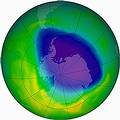 世界氣象組織(World Meteorological Organization, WMO)18日表示,2007年南極臭氧層破洞的情形相對來說有比較小了一點,但這並不表示臭氧層開始復原;反之,臭氧層破洞面積縮小是和今年(2007年)南半球冬季南極平流層的氣溫較溫和有關。
世界氣象組織(World Meteorological Organization, WMO)18日表示,2007年南極臭氧層破洞的情形相對來說有比較小了一點,但這並不表示臭氧層開始復原;反之,臭氧層破洞面積縮小是和今年(2007年)南半球冬季南極平流層的氣溫較溫和有關。
聯合國氣候及氣象委員會表示,從1998年開始,只有2002年和2004年臭氧層破洞情形比今年還要小。
南極上空臭氧層破洞情形和2006年相較縮小了約30%,而根據歐洲太空總署(European Space Agency)氣候偵測衛星Envisat所做的偵測顯示,2007年臭氧耗損最高紀錄約2770萬噸;相較之下,2006年的臭氧耗損紀錄則高達4000公噸。
2007年臭氧層在破洞面積和臭氧耗損量方面都有比較小一點,2007年臭氧破洞面積約2500萬平方公里,而當臭氧在與氯、溴、氮、氫和氧氣等氣體相互作用時則會產生耗損。
The Antarctic ozone hole this year is relatively small, but its size is not a sign of ozone recovery, the World Meteorological Organization, WMO, said Thursday. Instead, the smaller size of the ozone hole is related to the mild temperatures in the Antarctic stratosphere during the 2007 southern hemispheric winter.
Since 1998, only the ozone holes of 2002 and 2004 have been smaller than this year's hole, said the UN's climate and weather agency.
The ozone hole over Antarctica has shrunk 30 percent as compared to last year's record size. Measurements made by the European Space Agency's Envisat satellite show that this year's ozone loss peaked at 27.7 million metric tons, compared to the 2006 record ozone loss of 40 million tonnes.
The 2007 ozone hole is relatively small both in terms of area - about 25 million square kilometers - and the amount of ozone destruction, which occurs when ozone reacts with chlorine, bromine, nitrogen, hydrogen, and oxygen gases.
全文及圖片詳見ENS



